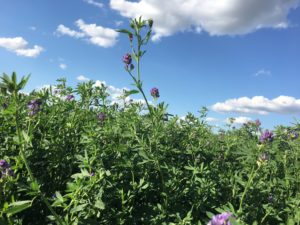Alfalfa in the Deep South: Three things to do by Spring
Right now is the opportune time to implement management plans that can impact the entire Alfalfa growing season. Taking the time to get out in your field and making informed decisions can help in regards to fertility needs and pest control. Below are three things to do by spring!
1) Fertilize for Stands to Survive
Soil fertility is one of the most important inputs in establishing and maintaining Alfalfa stands. Making sure you have the proper environment at planting is only the first step in Alfalfa management, continuing to pay attention and have timely fertility applications throughout the life of your stand improves both stand longevity and yield. Potassium fertilization is key, especially when managing alfalfa in the Deep South! Whether on Piedmont or Coastal Plains soils – now is the time to prepare for your first potassium application. Some things to remember:
 Don’t Guess, Soil Test! In late winter/early spring, take a soil test to determine what your macro- and micronutrient needs are prior to fertilization.
Don’t Guess, Soil Test! In late winter/early spring, take a soil test to determine what your macro- and micronutrient needs are prior to fertilization.- Micronutrients such as boron and molybdenum are very important in alfalfa stand maintenance. Molybdenum should be applied every other year in spring before new shoots reach 2 to 3 inches in height.
- Pay Attention to Potassium! Stand longevity and improved yields have been seen when potassium applications are split across the growing season. In Piedmont soils, two (spring and summer) or three (spring, summer, fall) applications should be sufficient; Coastal Plain soils do not hold K as well as heavier soils therefore more frequent applications are recommended beginning in later winter and continuing through fall.
2) Meet Forage Needs by Controlling Weeds
The first step in weed management is being judicious with weed identification and control before the weeds are large and a visible problem. Right now is a great time to get out in your field and identify if you have weeds that can have a negative impact on alfalfa yield and quality and to develop a management plan for current and potential future weed control.
For effective control of potential problem weeds including annual grasses and broadleaves such as crabgrass, foxtails, henbit, and pigweed, consider a pre-emergent herbicide application in the spring before weed seed has germinated and alfalfa has reached 6 inches in growth.
3) When in Doubt, Scout
There are a wide variety of insect pests that love to attack Alfalfa in the Deep South. The best way to know if you have a pest problem and if it needs to be treated is by scouting your field on a regular basis. Pay attention to the time of year, know what pests are likely present during that time, and know what specific symptoms to look for. The use of sweep nets and/or the “bucket method” can be helpful in determining insect presence and thresholds for treatment. Scouting should occur often throughout the year, at least weekly during the active growing season, and field reports should be maintained to help determine if an insect population is increasing or decreasing and what treatments have been or may need to be applied.
Insects to be on the lookout now through spring: Alfalfa Weevil and Aphids
Judicious management of alfalfa including maintaining proper fertility and regular scouting of weeds and insect pets will help to increase stand persistence!
*For specific fertility and herbicide recommendations for your area, please contact your local extension office and state extension webpage.
